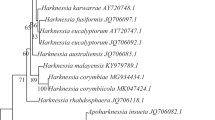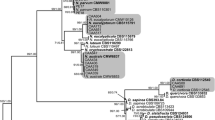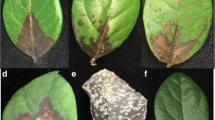Abstract
Diseases associated with Botryosphaeriaceae are widespread in Eucalyptus plantations in southern China. A high species diversity of Botryosphaeriaceae exists in these plantations, including species in the genera Botryosphaeria, Cophinforma, Lasiodiplodia, and Neofusicoccum. Botryosphaeriaceae fungi isolated from Eucalyptus and adjacent plants can be pathogenic to Eucalyptus trees. However, few field studies have assessed the tolerance of Eucalyptus genotypes to Botryosphaeriaceae. Twenty-two isolates representing 14 Botryosphaeriaceae species identified from Eucalyptus and adjacent plants were inoculated on the seedlings of a widely planted Eucalyptus genotype in a greenhouse. The greenhouse inoculation results showed that most isolates of Lasiodiplodia species were more pathogenic than the isolates of Botryosphaeria, Cophinforma, and Neofusicoccum species. Based on the greenhouse inoculation results, five highly pathogenic isolates, including one isolate of L. hormozganensis, two isolates of L. pseudotheobromae, and two isolates of L. theobromae were inoculated on trees of 20 Eucalyptus genotypes in the field to evaluate the tolerance of these genotypes. The resistance of the 20 Eucalyptus genotypes to each of the five Lasiodiplodia isolates was variable. The average lesion lengths produced by the five Lasiodiplodia isolates on each of the 20 Eucalyptus genotypes indicated that there were significant differences in tolerance among the Eucalyptus genotypes. This study evaluated the tolerance levels of 20 Eucalyptus genotypes, that are widely planted in southern China, to highly pathogenic Botryosphaeriaceae species.




Similar content being viewed by others
Availability of data and material
Data used in this manuscript will be available from the corresponding author with reasonable request.
References
Aćimović SG, Rooney-Latham S, Albu S, Grosman DM, Doccola JJ (2018) Characterization and pathogenicity of Botryosphaeriaceae fungi associated with declining urban stands of coast redwood in California. Plant Dis 102:1950–1957
Chen SF, Pavlic D, Roux J, Slippers B, Xie YJ, Wingfield MJ, Zhou XD (2011) Characterization of Botryosphaeriaceae from plantation-grown Eucalyptus species in South China. Plant Pathol 60:739–751
Coppen JJW (2002) Eucalyptus: the genus Eucalyptus. Taylor & Francis, London
Dissanayake AJ, Phillips AJL, Li XH, Hyde KD (2016) Botryosphaeriaceae: Current status of genera and species. Mycosphere 7:1001–1073
IBM Corp (2013) IBM SPSS statistics for windows, Version 22.0. Armonk, New York, USA
Li GQ, Arnold RJ, Liu FF, Li JQ, Chen SF (2015) Identification and pathogenicity of Lasiodiplodia species from Eucalyptus urophylla × grandis, Polyscias balfouriana and Bougainvillea spectabilis in southern China. J Phytopathol 163:956–967
Li GQ, Liu FF, Li JQ, Liu QL, Chen SF (2018) Botryosphaeriaceae from Eucalyptus plantations and adjacent plants in China. Persoonia 40:63–95
Li GQ, Slippers B, Wingfield MJ, Chen SF (2020) Variation in Botryosphaeriaceae from Eucalyptus plantations in YunNan Province in southwestern China across a climatic gradient. IMA Fungus 11:22
National Forestry and Grassland Administration (2019) China forest resources report (2014–2018). China Forestry Publishing House, Beijing (in Chinese)
Pavlic-Zupanc D, Maleme HM, Piškur B, Wingfield BD, Wingfield MJ, Slippers B (2017) Diversity, phylogeny and pathogenicity of Botryosphaeriaceae on non-native Eucalyptus grown in an urban environment: A case study. Urban for Urban Green 26:139–148
Phillips AJL, Alves A, Abdollahzadeh J, Slippers B, Wingfield MJ, Groenewald JZ, Crous PW (2013) The Botryosphaeriaceae: genera and species known from culture. Stud Mycol 76:51–167
Rodríguez-Gálvez E, Hilário S, Lopes A, Alves A (2020) Diversity and pathogenicity of Lasiodiplodia and Neopestalotiopsis species associated with stem blight and dieback of blueberry plants in Peru. Eur J Plant Pathol 157:89–102
Slippers B, Burgess T, Pavlic D, Ahumada R, Maleme H, Mohali S, Rodas C, Wingfield M (2009) A diverse assemblage of Botryosphaeriaceae infect Eucalyptus in native and non-native environments. South For 71:101–110
Slippers B, Crous PW, Jami F, Groenewald JZ, Wingfield MJ (2017) Diversity in the Botryosphaeriales: Looking back, looking forward. Fungal Biol 121:307–321
Slippers B, Fourie G, Crous PW, Coutinho TA, Wingfield BD, Carnegie J, Wingfield MJ (2004) Speciation and distribution of Botryosphaeria spp. on native and introduced Eucalyptus trees in Australia and South Africa. Stud Mycol 50:343–358
Slippers B, Wingfield MJ (2007) Botryosphaeriaceae as endophytes and latent pathogens of woody plants: diversity, ecology and impact. Fungal Biol Rev 21:90–106
Xie YJ, Arnold RJ, Wu ZH, Chen SF, Du AP, Luo JZ (2017) Advances in eucalypt research in China. Front Agric Sci Eng 4:380–390
Yang T, Groenewald JZ, Cheewangkoon R, Jami F, Abdollahzadeh J, Lombard L, Crous PW (2017) Families, genera, and species of Botryosphaeriales. Fungal Biol 121:322–346
Yu L, Chen XL, Gao LL, Chen HR, Huang Q (2009) First Report of Botryosphaeria dothidea causing canker and shoot blight of Eucalyptus in China. Plant Dis 93:764–764
Acknowledgements
We thank Ms. Wen Wang and Mr. QuanChao Wang for their assistance in conducting pathogenicity tests. We thank LetPub (www.letpub.com) for its linguistic assistance during the preparation of this manuscript.
Funding
This study was initiated through the bilateral agreement between the governments of South Africa and China and supported by The National Key R&D Program of China (China-South Africa Forestry Joint Research Centre Project; project No. 2018YFE0120900), the National Ten-thousand Talents Program (Project No. W03070115), and the GuangDong Top Young Talents Program (Project No. 20171172).
Author information
Authors and Affiliations
Contributions
G.Q. Li conducted the experiments, analyzed the data and wrote the first draft of the manuscript, S.F. Chen designed the research and revised the manuscript. W.P. Chen and F. Jie supplied the Eucalyptus plantations and conducted the experiment with G. Q. Li.
Corresponding author
Ethics declarations
Ethics approval
This study does not contain studies with human participants or animals performed by the author.
Consent to participate
All owners of the Eucalyptus trees used in the field experiments have agreed to publishing the data collected from the field.
Consent for publication
All authors fully agreed to the publication of the manuscript.
Conflict of interest
The authors have no conflicts of interest to declare that are relevant to the content of this article.
Additional information
Publisher's Note
Springer Nature remains neutral with regard to jurisdictional claims in published maps and institutional affiliations.
Rights and permissions
About this article
Cite this article
Li, G., Chen, W., Jie, F. et al. Selection of tolerant Eucalyptus genotypes to Botryosphaeriaceae species in southern China. J Plant Pathol 104, 527–535 (2022). https://doi.org/10.1007/s42161-022-01109-y
Received:
Accepted:
Published:
Issue Date:
DOI: https://doi.org/10.1007/s42161-022-01109-y




